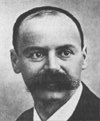
| Home |

|
PREFACE | PRIMEVAL | SPECIAL | GENERAL | CONCLUSION |
| Dictionary | Newton | Equivalence | Einstein | Schwarzschild |
 |
|---|
| K. Schwarzschild (1873-1916) |
Just months after Einstein published his work on his Theory of Gravitation, Karl Schwarzschild (1916) found one solution to Einstein's equations: the curvature due to a massive nonrotating spherical object. That is, using Einstein's equation, Schwarzschild had determined how spacetime is curved due to the presence of a nonrotating spherical mass. In practical terms, the Schwarzschild spacetime describes the gravitational field of the Sun, or of the Earth. (The Sun and the Earth do rotate, but this rotation is negligible in these cases.)
This spacetime was studied carefully, and it led to a few physical predictions.
Firstly, it did as good a job as Newton's Theory of Gravity in explaining the motion of the planets around the sun.
Second, it accounted for a tiny effect concerning the path of the planets ("The Anomalous Advance of the Perihelion") that Newton's Theory was unable to completely account for. The orbit of Mercury was studied, and the prediction was confirmed.
Thirdly, it predicted a value for a tiny effect concerning the path of light-rays ("The Bending of Starlight") that Newton's Theory was unable to completely account for. Light from a star passing near the sun was studied. The Einstein Theory correctly predicted the amount of the deflection of starlight. (For practical purposes, one could only make the observation during a solar eclipse since sunlight was much brighter than the starlight to be studied.)
Einstein's Theory (applied to Schwarzschild's Spacetime) was successful.
The spacetime of a black hole is curved in such a way as to cause the future light cones to tip inward. At a specific distance from the black hole, the light cones are so tipped-over that the "outgoing edge" of each light cone is vertical in the diagram below. These "edges" form a surface (drawn as a cylinder in the diagram). This surface (called the event horizon) is the characteristic feature of a black hole.
The event horizon is a boundary that divides this spacetime into an "inside" and an "outside". Once inside, particles and light-rays can never escape outside. In fact, since all of the light cones point to the singularity (a really bad place), their worldlines will end. (Realize that the light cones restrict the fates of worldlines that encounter them.)
from Penrose, (Scientific American)
The following diagram shows an observer's worldline in the outside region. This observer is periodically sending out light-pulses. The light-pulses could be detected by, say, another observer who ventures into the black hole.
from Geroch, (General Relativity from A to B)
The following diagram shows a foolish observer's worldline in the outside region, venturing into the black hole. This observer is periodically sending out light-pulses. However, notice that the closer our foolish observer gets, the longer it takes for his pulses to reach an outside observer. Before he reaches the event horizon, the observer can still return to the outer regions of the outside region... but the longer he waits, the longer it will take him to return.
Just after the foolish observer crosses the event horizon (at event u), his light-pulses never reach an outside observer. And since his light-pulses can't reach the outside, no particle (for example, his spaceship) can reach the outside.
Now, once inside, the light cones now direct him to the singularity. His life will soon be over: his worldline will end.
from Geroch, (General Relativity from A to B)
| Home |

|
PREFACE | PRIMEVAL | SPECIAL | GENERAL | CONCLUSION |
| Dictionary | Newton | Equivalence | Einstein | Schwarzschild |